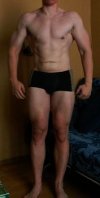Just a different kind of stress that's known to increase muscle in size. We can only guess what's happening in there and what exactly drives stress-induced compensatory growth to be able to target it optimally. But one thing is most likely for sure: body gets better at something when imposed under contrasted stimulus. Which is the reason behind HST. Decondition a muscle and hit it again with loads it's unaccustomed to. There's got to be a better way than the obvious "get stronger to get bigger". There's nothing wrong in getting stronger, it's an attractive and rewarding goal, I myself do it now in rack pulls

But this can't be the only way to grow muscle, there are surely natural tricks to do that.
You're blinded by bias in this statement. No, I'm not picking another argument. But purely from the sake of logic, you're ignoring the fallacy of your statements.
Firstly, Exposure to new loads IS exactly what strength training is. It replaces SD with increasing the load. And if you apply the correct volume and frequency, choice of lifts and general workload, then you get bigger as well.
Are there other ways to get bigger? Probably, are they optimal? Not really. HST itself is just a periodised strength straining program that utilises deconditioning (which is just a form of extreme deloading).
Secondly, without sufficient stimulus (load), you aren't going to induce the physiological stimulus to build bigger muscles. There's no "trick" or shortcut here. You need to cause the damage to the muscle (stimulus) to make it grow. Deloading/deconditioning is a way to do that - as you note, the muscle is not sufficiently accustomed to the load and until it gets bigger, it won't be. Adding excessive volume is not a way to do that, and pretty much every experience of every bodybuilder/resistance trainee reflects that (e.g. 'bodypart splits' - whereby you designate one muscle group per day and hit it with 20-30 sets of various exercises).
Lastly, I'm curious as to why you feel "There's got to be a better way than the obvious "get stronger to get bigger" " ? I'm struggling to think of a rational explanation for
why there would be a more efficent physiological explanation for this. The human body, as is the case for all of life, responds to stimulus. The physiological purpose of extra skeletal purpose is to make the body stronger - think in evolutionary terms; run faster, fight stronger, be more imposing/intimidating to potential threats, better protection of territory, more appealing to potential mates.
The stimulus to trigger the cascade for formation of that muscle is exposure to the need (move something heavy). Similar stimuli-response mechanisms are skin tanning/darkening, inflammatory responses, callus and thickened skin development, digestive responses to food being eaten and so on.
The most efficient (ala effectiveness relative to time spent) and natural mechanism to build more muscle is to expose it to the stimulus; increased load.
Are there are ways to grow muscle? Obviously. The most efficient in absolute terms is steroid use; just tell the DNA what to do without needing the external stimulus to cause an internal physiological stimulus (that then moderates the muscle building response). Lighter load-higher volume programs are effective up to a point, although just about every study published has indicated that the extra volume is superfluous.
Your question at the end of your statement is extremely puzzling; why do you think there are "natural tricks" that would be more efficient than the (thus far) proven mechanism to grow muscle (load progression)? I'm pretty sure that over a few million years that evolution nailed the best way to do it. Is it a case of us not figuring it out yet? I suppose that's always possible, although you're still missing any impartial evidence that training with lighter loads will induce a better response than training with heavier loads?
The trick is to lift heavier than your muscles are accustomed/acclimated to.
Question: why are you afraid to get stronger in order to get bigger? This has always puzzled me. They're inextricably linked, though not linearly. You don't get muscular people who are weak, and you don't get absolutely strong guys who are small. Sure, power lifters and Olympic lifters perform difficult techniques with very good precision and they squeeze every measure of biomechanical energy they can out of those techniques; but they aren't small relative to their skeletons, even at lower weight classes. And furthermore, most have a problem with staying within their weight class, rather than struggling to gain size.

